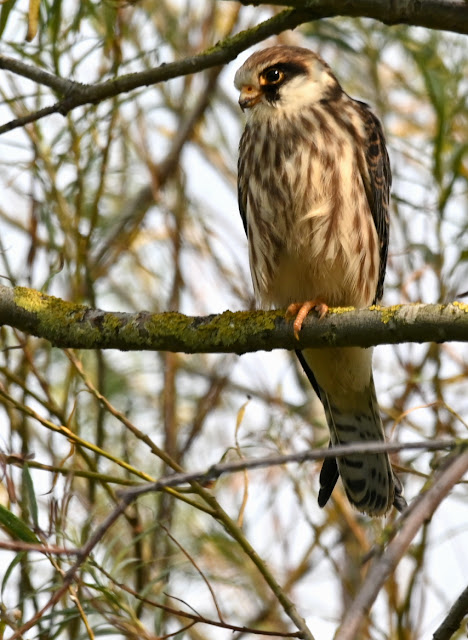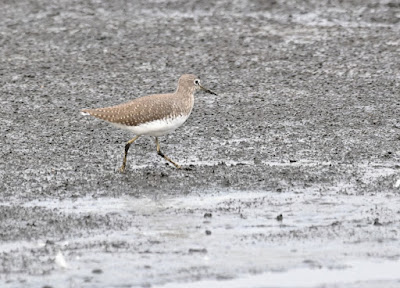The Safari got a txt from old friend TS the other morning telling us that the Hobby we'd seen reported on the local birders' WhatsApp group at Marton Mere was still there. Not having seen one there for many years, and not anywhere else for only slightly fewer and not hardly having been there at all this year we decided to go and have a look, it shouldn't be too busy as the schools have gone back to the annoying adjacent caravan site would be a lot quieter.
The walk in was very quiet, just a calling Chiffchaff and Blackcap breaking the warm silence. We soon found out where to look as a couple of other birders were stood half way down the main drag looking towards a particular bush. We stopped and scanned and saw the unidentifiable silhouette of a small falcon perched on the edge of said bush. Joining the others, who were unable to see it on the far side of the bush, we stood waiting and chatting until it decided to hop around a bit - which eventually it did.
It did perch up in nearby Willow tree for a while too.And so onto Day 3, gosh - hardly been to the reserve all year and now thrice in three days! This time we had CR as company. But we couldn't find it anywhere, then TS came along and told us it had been favouring the NE corner the previous evening, so we had a look there and met other birders looking too but to no avail - had it moved on after an earlier shower? We took the opportunity to do a circuit of the reserve, noting not a lot apart from a few Cetti's Warblers singing half-heartedly from unseen perches deep in the reeds. As we come towards the NE corner along the embankment we could see a bigger pack of birders and they looked to be looking at something - sure enough when we approached there was the Red-footed Falcon sitting almost directly over the path in a tall Willow tree.At last a decent view in decent light but we still couldn't manage any half-good flight shots...and still nothing else to point the camera at.
Another white bird was first up though, we'd passed through the check-in desk and through the facing window we could see an egret sat on a pontoon in middle of the lake. A telescope was set up in the window too, manned by a volunteer - not seen that before. Well it was a Cattle Egret hence the excitement, they're sort of regular just inland of the Ribble estuary now, more so on the south side but there may be not so many records from this site which is a little further inland still but does have the herd of Longhorn Cattle grazing sort of naturally on the wet fields so Cattle Egrets might be expected to turn up there.
When we started birding you had to go to the Carmargue in southern France, the Ebro delta in SE Spain or SW Spain and southern Portugal to see these - how times change!
JG was already in the Discovery Hide when we'd finished gawping at the egret and pointed out a few Ruff and a Buzzard on a post, there's always a Buzzard on a post at this reserve. Something put the Lapwings and gulls up and in the throng we picked out a Mediterranean Gull but it must have left the reserve with most of the other gulls as we never saw it again all day despite concerted efforts whenever the gulls were in view.
Moving round to the screens before the rest of the crew arrived at the first one we had great views of a snoozing juvenile Shelduck, a stunning pair of Lesser Black-backed Gulls, iridescent Lapwings and a deep wading Snipe.
The second screen provided a lone Black-tailed Godwit and a Green Sandpiper obliged by flying in and running round in the gloopy mud in front of us.
We arranged to meet the late arriving remainder of the gang at the Feeding Station so sat up there for a while enjoying the Brown Rats (always a star attraction for us), Greenfinches and Goldfinches on offer. No sign of any Willow Tits this morning although there were very few of the regular Blue and Great Tits knocking about.
The gang arrived and had a quick look before moving on to the Harrier Hide with it's throngs of feral Canada and Greylag Geese. A couple Little Grebes and Gadwall broke the gooses' monopoly on the water while overhead a small number of Sand Martins tazzed about. The most exciting wildlife wasn't a bird though, a tiny orange beetle was clambering about the shelf and AB's camera, on closer inspection by AB he declared it to be a type of Leaf Beetle. A few photos and a bit of research later it was identified as one of the Sphaerodermas, of which there are two species to choose from in Britain. All the info about them is here.
Time to move on - we hit the UU Hide to enjoy distant views of not a lot. Easily pick of the bunch was an arriving but immediately disappearing Kingfisher which put in a second brief appearance a few minutes later and a quality Kestrel hovering not too far away.
Another Green Sandpiper flew in but landed on a muddy pool miles away. They do remind us of giant - well not that giant - House Martins when they swoop across the water. Scanning around we found a Buzzard on a post, a Buzzard on a stick, a Buzzard on a gate and a Buzzard on a bonfire with a distant Marsh Harrier to break the Buzzard monotony. With not a lot else happening we soon moved on to the next hide. Well would you believe it we couldn't get in - the ginormous camera brigade were in there and not for sharing the space so we didn't stay. Lunch beckoned anyway so it was no hardship turning back and we got great views of a bright Comma butterfly on the path outside the hide.Back at the reception area we met our remaining late arriving gang member and aimed for our butties in the boot of the car while noting that the earlier Cattle Egret was no longer on its pontoon.
After a selection of butties, chips, salads and more were eagerly scoffed it was time to hit the trail again. T'other way this time to the as yet unvisited hides. Nowt doing in the first three but that's only to be expected at this stage of the autumn as the wintering ducks and geese from the northern latitudes haven't arrived yet, another week or so and they'll start steaming in.
From the elevated Kingfisher Hide we watched a juvenile male Marsh Harrier cruising around and the Cattle Egret appeared landing among the Longhorn Cattle where the scene was looking decidedly primaeval.
No Tree Sparrows were on the feeders nor were there any on the walk up - where are they we wondered, they're always along this stretch.
On the approach to the final hide there's a pool, sheltered by some tall Willows and a hedge, this sheltered area was absolutely hooching with dragonflies, mostly Migrant Hawkers with a few Common Darters thrown in for good measure. It was like a scene from a tropical documentary they were everywhere, dozens of them, absolutely awesome. And looking good for a Hobby slicing through in search of an easy meal or two. But when a passing cloud obscured the sun they disappeared. Well not quite they were spotted roosting up high in the tree tops of the hedge waiting for the sun to come back out. Some trees had good numbers - here's a couple of twigs with seven Migrant Hawkers on them.
We stopped at the Discovery Hide on the way to the car just to check the gulls but alas very few gulls were visible. The couple in there had seen a Stoat or a Weasel a few times hunting among the rocks but it refused to show for us. Then just as we'd got through the door it reappeared - black tipped tail they said so a Stoat.
And that was that, time to go after a great day with great company, lots of laughs catching up and reminiscing and lots of fantastic wildlife too.
Where to next? Not sure yet, new Base Camp is having some modifications so we mightn't be very far afield for a while but you never know what we might find on the garden or a cuple paces from the front door - it's all out there just waiting to be seen.
In the meantime let us know who's been tazzing through your outback.

















1 comment:
I really enjoyed your blog posts thank you
Post a Comment